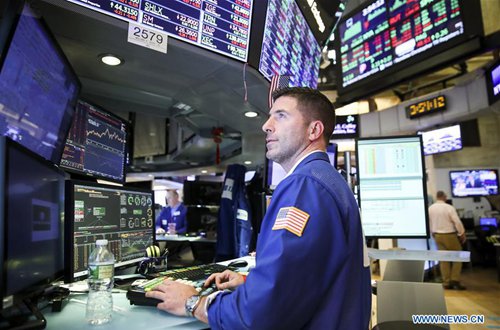HOME >> SOURCE
Wall Street posts solid weekly gains as US-China trade progress in focus
Source:Xinhua Published: 2019/12/14 19:08:37

File photo: Xinhua
US equities posted solid gains in the week, as investors anticipated trade progress between the world's two largest economies.
For the week, the S&P 500 and Nasdaq Composite Index climbed 0.7 percent and 0.9 percent respectively, while the Dow Jones Industrial Average advanced 0.4 percent.
The market reacted positively on Friday, thanks to the US-China phase-one economic and trade deal. The Dow closed up 0.1 percent to 28,135.38, after hitting a record high at 28,290.73. The S&P 500 index eked out a new record, closing at 3,168.80, while the Nasdaq finished 0.2 percent higher at 8,734.88, also a record.
China said in a statement that the two countries have agreed on the wording of a phase-one economic and trade agreement based on the principles of equality and mutual respect, and have reached a consensus that the US side will fulfill its commitments to phasing out additional tariffs on Chinese imports.
"It's encouraging," said Peter Tuchman, an experienced trader on the floor of the New York Stock Exchange, who added that he believes the record levels of the market obviously have something to do with the anticipation of a deal.
"Our economies are incredibly intermingled," he said, adding "there are so many stocks with exposure to China," since the two countries are key trading partners.
Trade issues have been a big part of market anxieties since last year. A seasoned trader, Tuchman is hopeful that more progress could be made to exert a further positive impact on the market.
This week also highlighted a closely-watched rate decision by the US Federal Reserve.
The Federal Open Market Committee (FOMC), the Fed's policy-making committee, decided to maintain the target range for the federal funds rate at 1.5 percent to 1.75 percent, after concluding a two-day policy meeting on Wednesday, in line with market expectations.
The Fed also said in a statement that it will continue to monitor the implications of incoming information for the economic outlook, as it assesses the appropriate path of the target range for the federal funds rate.
The US central bank signaled no immediate appetite for rate hikes, removing the fear of tightening monetary policy among investors, according to some experts.
"The FOMC left interest rates unchanged today with no dissents. The dot plot shows no change in rates next year," Chris Low, chief economist at FHN Financial, said about the Fed's statement.
The Fed has lowered interest rates three times since July, amid growing risks and uncertainties stemming from trade tensions, weakness in global growth, and muted inflation pressures.
On the data front, US retail sales increased by 0.2 percent in November, the Department of Commerce reported on Friday. Economists polled by Reuters had forecast retail sales would accelerate by 0.5 percent.
In the week ending Dec. 7, initial jobless claims in the US, a rough way to measure layoffs, jumped by 49,000 to 252,000, the Department of Labor reported Thursday. This is the highest level for initial claims since the end of September 2017, said the department.
US small-business owners' confidence rose 2.3 points to 104.7 points in November, posting its biggest month-over-month gain since May 2018, according to a report by the National Federation of Independent Business on Tuesday.
Looking ahead, analysts said updates on the US-China trade and the holiday season are among the focus for investors who are expecting to close out the year on a positive note.
Posted in: BIZ FOCUS